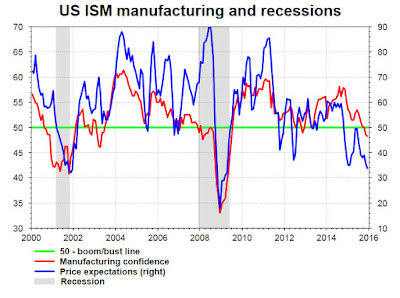Judging by the trading performance so far in 2016, it has not been the best of starts for global markets and the worry is that it sets the tone for another troubled year. Stock market mayhem and rising investor unease is not good news when the pace of global growth is starting to stumble.
It
is hard to credit after seven years of stock market rally that the bubble is
about to burst, especially considering the world economy is so flush with
liquidity after years of monetary pump-priming by the major central banks.
Ever
since the global financial crisis first exploded onto the scene in 2008, world
policymakers have waged a fierce policy offensive with quantitative easing,
ultra low interest rates and a plethora of super-stimulus to get the world economy
back on its feet. Despite all this monetary balm, markets seem to have reached
a crossroads.
The
special measures have either run out of steam and fresh policy efforts are
needed, or else global stock markets have reached their natural peak and are
set for a corrective downward spell. It is a combination of both, plus the fact
that the global economy is still experiencing painful aftershocks from the
global financial crisis.
Reverberations
of deep recession, deflation, high unemployment, austerity cutbacks and severe
balance sheet restructuring are still resonating. Years of easy money from the
global monetary authorities might have averted deeper disaster in the immediate
aftermath of the 2008-9 financial crisis but the world economy is still far
from fixed.
Stock market uncertainty is telling the world’s economic leaders some important truths. Stock prices are forward leading indicators of investors’ future expectations. If share markets are distressed it means confidence in the future has been undermined. Investors selling assets is the only way to limit anticipated risks ahead.
Central
bankers have railed in recent years over ‘irrational exuberance’, excessive investor
risk-taking and the dangers of stock market bubbles but the tables have now turned.
Global policymakers must acknowledge the market’s rising ‘rational despair’ and
do something much more meaningful to correct it.
There
have been telltale signs of deepening troubles in the world economy for quite a
while. Swathes of economic reports and downbeat confidence surveys have pointed
to global growth losing significant forward momentum. Slower growth in China, tensions
in the Middle East and the collapse in global commodity prices are all weighing
on global optimism right now.
Purchasing
managers reports have highlighted the weakening trend of global economic
activity for well over a year. Compared with 12 months ago, many major
economies have edged below the critical 50 boom-or-bust threshold, suggesting
economic growth is heading into a contractionary phase.
Critically,
the US manufacturing PMI has seen a sharp reversal in fortunes over the last
year, with surveys suggesting the pace of US economic demand is slowing down
quite rapidly. This is in sharp contrast with the picture portrayed by the fast
pace of US employment expansion in last week’s 292,000 non-farm payrolls surge
for December.
Right
now, the US Federal Reserve seems solely focused on stronger employment trends and
ignoring the unsettling PMI message. The data not only alludes to weaker
economic activity ahead, but also pin-points a continuing deflation threat with
price expectations running at their lowest level for nearly 7 years.
The
worrying aspect is the Fed remains so dead set on pushing rates higher. The
Fed’s whispering campaign suggests a number of key officials would even prefer to
see 4 to 5 more rate rises this year. If the Fed is so determined to press
ahead with tightening, the bigger risk is at what stage the central bank starts
the ‘great unwind’ of its 4-1/2 trillion dollar hoard of QE purchases. That would
spark a major blow-out in US bond yields.
It
is the sting in the tail for investors. With the world’s largest economy so committed
to policy tightening, it means borrowing rates for the indebted nations around
the world are going up. This is bad news for global economic confidence and
growth.
There
are few places left for investors to run and hide. Traditional safe haven bond
markets, like German government bonds, are heavily over-subscribed and carrying
negative yields across much of the yield curve. The investment challenge this
year will be finding secure boltholes, with negligible risk and positive
expected return.
2016
has the makings of a really tough year for investors. But it will be even more
demanding for global policymakers seeking solutions.


This comment has been removed by a blog administrator.
ReplyDelete